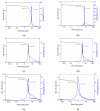Pore Structure Tuning of Poly-EGDMA Biomedical Material by Varying the O-Quinone Photoinitiator
- PMID: 37299356
- PMCID: PMC10255199
- DOI: 10.3390/polym15112558
Pore Structure Tuning of Poly-EGDMA Biomedical Material by Varying the O-Quinone Photoinitiator
Abstract
Porous polymer monoliths with thicknesses of 2 and 4 mm were obtained via polymerization of ethylene glycol dimethacrylate (EGDMA) under the influence visible-light irradiation in the presence of a 70 wt% 1-butanol porogenic agent and o-quinone photoinitiators. The o-quinones used were: 3,5-di-tret-butyl-benzoquinone-1,2 (35Q), 3,6-di-tret-butyl-benzoquinone-1,2 (36Q), camphorquinone (CQ), and 9,10-phenanthrenequinone (PQ). Porous monoliths were also synthesized from the same mixture but using 2,2'-azo-bis(iso-butyronitrile) (AIBN) at 100 °C instead o-quinones. According to the results of scanning electron microscopy, all the resulting samples were conglomerates of spherical, polymeric particles with pores between them. Use of mercury porometry showed that the interconnected pore systems of all the polymers were open. The average pore size, Dmod, in such polymers strongly depended on both the nature of the initiator and the method of initiation of polymerization. For polymers obtained in the presence of AIBN, the Dmod value was as low as 0.8 μm. For polymers obtained via photoinitiation in the presence of 36Q, 35Q, CQ, and PQ, the Dmod values were significantly greater, i.e., 9.9, 6.4, 3.6, and 3.7 μm, respectively. The compressive strength and Young's modulus of the porous monoliths increased symbatically in the series PQ < CQ < 36Q < 35Q < AIBN with decreasing proportions of large pores (over 12 μm) in their polymer structures. The photopolymerization rate of the EGDMA and 1-butanol, 30:70 wt% mixture was maximal for PQ and minimal for 35Q. All polymers tested were non-cytotoxic. Based on the data from MTT testing, it can be noted that the polymers obtained via photoinitiation were characterized by their positive effect on the proliferative activity of human dermal fibroblasts. This makes them promising osteoplastic materials for clinical trials.
Keywords: camphorquinone; cytotoxicity; ethylene glycol dimethacrylate; o-benzoquinone; phenanthrenequinone; photoinitiator; porosity; scanning electron microscopy; strength properties; visible radiation.
Conflict of interest statement
The authors declare no conflict of interest.
Figures








Similar articles
-
Porous Polymer Scaffolds based on Cross-Linked Poly-EGDMA and PLA: Manufacture, Antibiotics Encapsulation, and In Vitro Study.Macromol Biosci. 2021 May;21(5):e2000402. doi: 10.1002/mabi.202000402. Epub 2021 Mar 23. Macromol Biosci. 2021. PMID: 33759338
-
Porogen Concentration Effect on the Pore Structure and Properties Evolution of Polymer Monolith Based on Oligocarbonate Dimethacrylate OCM-2.Materials (Basel). 2023 Apr 18;16(8):3177. doi: 10.3390/ma16083177. Materials (Basel). 2023. PMID: 37110013 Free PMC article.
-
Degree of conversion, depth of cure, and color stability of experimental dental composite formulated with camphorquinone and phenanthrenequinone photoinitiators.J Esthet Restor Dent. 2015 Mar-Apr;27 Suppl 1:S49-57. doi: 10.1111/jerd.12131. Epub 2015 Apr 17. J Esthet Restor Dent. 2015. PMID: 25886091
-
Porous polymer monoliths: morphology, porous properties, polymer nanoscale gel structure and their impact on chromatographic performance.J Chromatogr A. 2013 Apr 26;1287:39-58. doi: 10.1016/j.chroma.2012.11.016. Epub 2012 Nov 29. J Chromatogr A. 2013. PMID: 23261286 Review.
-
Porous polymer monoliths: an alternative to classical beads.Adv Biochem Eng Biotechnol. 2002;76:87-125. doi: 10.1007/3-540-45345-8_3. Adv Biochem Eng Biotechnol. 2002. PMID: 12126272 Review.
Cited by
-
Features of Changes in the Structure and Properties of a Porous Polymer Material with Antibacterial Activity during Biodegradation in an In Vitro Model.Polymers (Basel). 2024 Jan 30;16(3):379. doi: 10.3390/polym16030379. Polymers (Basel). 2024. PMID: 38337268 Free PMC article.
-
Specifics of Porous Polymer and Xenogeneic Matrices and of Bone Tissue Regeneration Related to Their Implantation into an Experimental Rabbit Defect.Polymers (Basel). 2024 Apr 20;16(8):1165. doi: 10.3390/polym16081165. Polymers (Basel). 2024. PMID: 38675083 Free PMC article.
References
-
- Bao C.L.M., Teo E.Y., Chong M.S., Liu Y., Choolani M., Chan J.K. Regenerative Medicine and Tissue Engineering. IntechOpen; Rijeka, Croatia: 2013. Advances in bone tissue engineering.
Grants and funding
LinkOut - more resources
Full Text Sources
Miscellaneous

